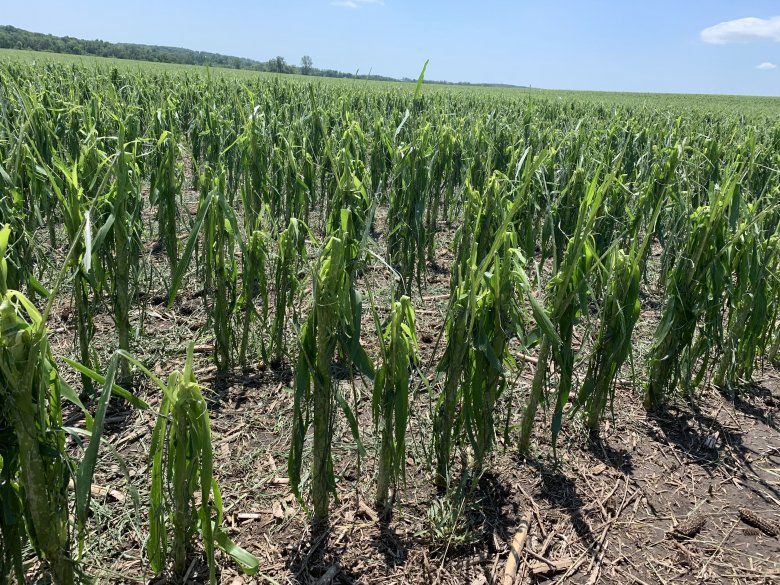Agronomists in Iowa, Nebraska and Missouri continue to assess crop damage from this week's hailstorm.
On Tuesday, a hailstorm dumping anywhere from 0.50-1.75"-sized hail made its way across the edges of eastern Nebraska and northern Missouri. In parts of Iowa, the storm took a 3-4 mile wide swath stretching from Sioux City to Centerville.
In central Iowa, dime to quarter-sized hail completely covered highways.
While the crop damage varied from soybean defoliation to stripped corn, one thing is for sure that the crops that were hailed on may have lost their top yielding potential.
In fact, at least one agronomist in central Iowa has seen his second hailstorm in as many weeks. And, the damage that each storm has done has varied.
Soybean Damage
Agronomically speaking, most of the Midwest soybean crop is in the V-8 to V-9 growth stage. In this stage, the plants are putting on a lot of trifoliates that include auxiliary buds. So, when the upper part of the plant has been compromised from such things like hail, the other growing points can compensate for the damaged ones.

Mike McGinnis
Jamie Brand, Pioneer agronomists for Mid-Iowa Seeds, says that the good news is that the younger the crop is and the less stress it has endured in its life the better bounce back opportunity.
"Last week's hailstorm really defoliated the plants and bruised the stems to the point that we don't know whether vascular tissue was damaged deplinishing its ability to continue to feed and bring nutrients up the stem. That process is needed for the young plant to take care of its auxiliary buds to eventually produce pods," Brand says.
This week's hailstorm dumped more hail but it was smaller in size.
"The soybean leaves did defoliate, but we are not seeing as much stress to the stems. So, the likelihood of having some abortion from vascular damage (moving water up the stem) is going to be less," Brand says.
Though he believes that the top yield potential has been lost, in most cases, Brand says that if the crop has to face hailstorms, now is the time to do it vs. three weeks down the road.
"Still, when you look at the economics of a replant, for farmers that don't have hail insurance, the majority of these beans have more potential to mend themselves vs. starting over with a new crop," Brand says. Where we have a stem that has not been vascularly damaged, plus two or three auxiliary buds, bounce back is very likely."
For soybeans that have been damaged by hail they could experience a slower developing canopy, especially with wide row spacing. Therefore, farmers are urged to pay close attention to weed management, regarding hail-damaged soybean leaves.
Damaged Corn
For the most part, the Midwest corn crop is in the V-9 to V-11 growth stages. This is the point where the plants start increasing their needs for water and nutrients up through the root system.
So, the concern with hail-damaged corn is the cost of leaf defoliation and stalk damage.

Mike McGinnis
"The concern is the plant's ability to grow an ear and handle the weight. This week's storm did tear leaves, but the integrity of the stalk was maintained. With multiple leaves developing, research will say that the most yield loss could be around 15%," Brand says.
He added, "If we don't have any issues with the stalk and no issues with the next whirl coming out, I would say the yield loss is less than that (15%)."
As of Wednesday, there is no estimate on total acreage impacted by the hailstorms.
The Link LonkJune 24, 2021 at 05:01AM
https://ift.tt/3gRkcCZ
Hailstorm cuts portion of Iowa's corn yield potential by 10-15%, agronomist says - Successful Farming
https://ift.tt/3gguREe
Corn

No comments:
Post a Comment